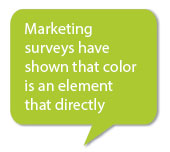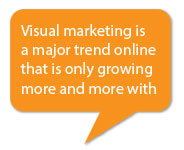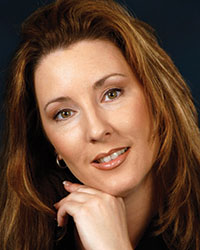Building trust and reliability with potential and current clients will lead not only to a loyal following, but will bring new clients in the door. What is important is learning how to tap into your brand’s authentic voice on social media and using that same voice in your visuals and all other content you post. Your voice, greeting, and overall communication style at the spa should carry over onto your social media platforms.
If time is a concern, designate different periods throughout the day that employees can post to social media – but first, make sure everyone is on the same page and will create a consistent theme across the board. On the other hand, you might consider designating one employee to manage all of your social media platforms. Either way, the goal is to create consistency and appealing content that is going to resonate with your followers.
 Visual Content - Why Your Marketing Needs Visuals
Visual Content - Why Your Marketing Needs Visuals
Visual marketing is a major trend online that is only growing more and more with popularity. Marketers who use visual content get an increase in engagement, more leads, and additional followers, which naturally result in higher earnings.
What is Visual Content?
When you think of visual content, you probably imagine images. While images are important, visual content includes many other formats such as:
- Videos (filming a spa service, product demonstration, or special event)
- Infographics (a visual representation of data or information that presents complex ideas in a simple way)
- Memes (usually a humorous image accompanied by text that conveys an idea or message and spreads virally throughout the Internet)
- Word art using applicable words for your industry
- Cartoons (representing spa images)
- Inspirational quotes accompanied by images
- Charts and graphs
- Brand logos
- Design elements (such as scrolls, arrows, flourishes, labels and ribbons to add a touch of flair)
Why Images are Essential
As the saying goes, a picture says a thousand words. People naturally respond to images. The human brain processes visual information much faster than text, which must be read and processed. Images communicate ideas in a more immediate way.
Images are especially effective in marketing because of their ability to tell a story. Stories resonate with people and can help create a strong bond between companies and their followers. These stories are especially effective when they can invoke a positive emotion.
Images are absolutely essential for branding. Your profile image on social media or brand logo is instantly recognizable to your audience. The colors and design features you use for your website and marketing materials instantly communicate your message. Just consider the Apple, Google, or Starbucks logos.
Finally, visual content is great for social media. Social media posts with visual content get 120 to 180 percent more engagement than text-only posts. Facebook has even changed its profile format to a timeline to make it more visually-oriented. There are also hundreds of popular social media websites such as Pinterest or Instagram made exclusively for sharing images.
 Visual Content Ideas
Visual Content Ideas
One obstacle that keeps more marketers from going visual is a lack of ideas. Companies should create anything that engages, entertains, or informs their audience.
One idea is to take information you would normally present in a text article and turn it into an infographic. Take something complex that you would like to teach your audience and turn it into a graphic that they can glance at and easily understand. A great way to do this is by using platforms such as visual.ly or inforgr.am.
Visuals can be added to regular content, too. Adding images to press releases to make them more appealing has become a recent trend in marketing. You can add videos to your blog posts to give your readers another way to consume and quickly understand the concepts you are trying to convey.
You can also ask your audience to generate your content for you. Visual content can be crowdsourced. Ask your audience to take pictures related to your products or that feature your products, and have them send the pictures to you so you can post them on your website or social media page. The idea behind social media is to lead your viewers to your website, not the other way around.
Creating Visuals is Easy
Many marketers are kept from using visuals because they feel their design skills are not up to par. You may think that you are not a great photographer and that this keeps you from incorporating photographs in your marketing campaigns. However, visual content creation tools make it easy for anyone to create wonderful, professional-grade images with little or no skill whatsoever. And sometimes, when the images are not as professional, they actually resonate more with your audience since it makes them think of you as more of a real person.
The Psychology of Color Schemes
Colors compose a secret language that only the human subconscious – and savvy marketers – can understand. There is a reason that the walls of your local fast food restaurant are orange, red, and yellow. These are colors that subconsciously excite you and stimulate your appetite. There is a science behind the calming shade of green of your favorite coffee shop’s cups and why there is so much red in casinos. The language of color is a huge advantage in the world of marketing.
How Color Works on the Mind
To say that seeing the color orange makes you hungry is an oversimplification. The orange countertops are not going to bring in customers who are full and make them eat. But marketing surveys have shown that color is an element that directly affects consumer behavior. Color plays on associations in the mind that can elicit certain responses, which is why it is one of the most powerful design elements on websites, advertisements, direct mail pieces, and other marketing materials.
Color Associations
Colors elicit responses, but these responses can vary slightly from person to person. However, according to recent marketing research, there are some common associations made with certain colors.
As mentioned before, red and orange are associated with excitement. Red reminds us of energy and movement. It is often used in calls-to-action and “buy now” buttons. Orange is associated with enthusiasm and cheerfulness. It is also often used to urge customers to
take action.
Blue and green have the opposite effect because they are calming colors. Blue reminds us of stability and security and is often used for business or technology websites where trust is important. Green has similar associations to blue and is also associated with money.
Pink, of course, reminds us of femininity. Yellow is an attention-grabbing color that the mind associates with youth and positivity. Although black can be seen as ominous, it is also associated with power, sleekness, and luxury. White, on the other hand, is associated with purity
and cleanliness.
 Using Colors Effectively
Using Colors Effectively
The best way to use color is as an overall theme. For example, if what you are selling is associated with fall, use fall colors such as earthy reds, browns, and oranges. If you are offering something beach-related, your website and marketing materials should contain the colors of the sand, ocean, and sunshine.
Your best color scheme depends on your market. If your spa is marketing to a more mature audience to whom stability and trust are important, use calm, muted colors. Retro colors work well when your market is young and hip. Always think carefully about what associations your color scheme could be triggering.
Thinking Outside the Box
It is good to stick to common knowledge about colors to err on the side of caution, but sometimes wildly unexpected colors work well. Your spa might use the traditional soft, muted colors. However, a more contemporary spa might use bolder and edgier colors.
Testing Your Market
While there are trends, there are no hard-and-fast rules when it comes to the colors of marketing. Cultures, markets, and individuals all react differently to different colors. Start by looking at color schemes in your niche and then choose accordingly. Test different colors to see which ones your market best responds to.
Building a Brand Atmosphere
When building a brand for your business, you must think about a visual scheme. There are many elements to consider when building a brand, such as colors, logos, shapes, and so on. Visual branding is an important part of having and expanding
a business.
How to Create a Visual Scheme for Your Brand
Building a brand is all about consistency. Your clients expect to have the same experience whenever they deal with your brand. This consistency will lead to client reliability and trust. An important part of creating a consistent brand image is to choose a visual scheme that will always be associated with your name or company’s name.
Design Schemes and Associations
How important is your brand’s visual scheme? Consider for a moment the mistakes big companies have made while trying to change the visual features of their products. Clear Coca Cola crashed and burned, because we expect it to be black. When Heinz produced green ketchup, it made appearances as a collectible on eBay, but not on kitchen tables.
Certain colors and design schemes are associated with certain products. If the product has the wrong color or design, it is off-putting to customers. Also, changing your image once you have already made an impact on your audience can be detrimental.
 Your Visual Brand Language
Your Visual Brand Language
To create a design and color scheme for your brand, you need to create a visual brand language. A visual brand language includes design elements such as shape, color, materials, finish, typography, and composition. All of these items together should communicate a company’s values and personality.
For a good example, take BMW’s front grill. When you see it on an advertisement or website, you automatically think of BMW and all the qualities associated with this luxury carmaker. This distinct design feature is used as a visual marketing tool by the company to trigger feelings and associations in the minds of its target market.
An important key to creating a visual brand language is to remember that it is not static, but can be changed and used in different ways. Consider Google’s logo, the basic letters on a clean white background. During different times of the year or during promotions, small changes are made to this basic design theme. Your visual brand language can be something flexible as well.
Visuals for Your Niche
Your images should create a brand atmosphere that corresponds with your spa’s niche market. Consider your target market and their interests. Think about your products and services and look at how other companies in your niche create their brand atmospheres. For example, some niches tend to favor stark visuals, while others use soft, retro filters. Each image a company uses fits with its atmosphere to create a sense of consistency across all of its marketing and
content creation.
Your Brand’s Logo
The single most important visual element is your logo. To create a logo, go back to your brand’s unique selling proposition. Decide what your brand’s promise and personality is. These should be communicated through your brand’s logo. Your logo must be based on this foundation and harmonize with your other design elements.
The best practice when designing a logo is to start by choosing a primary and secondary color. The primary color is for your symbol, icon, or lettering. The secondary color is for the background. Take advantage of color meanings and associations when choosing colors.
The Importance of Visual Branding
A common business mistake is bringing in outside visual experts as an afterthought, rather than a central part of the initial planning. Your brand’s visual plan is
just as important as your unique selling proposition or your products: It is part of your company’s basic image being presented to your target market.
Sharing Visual Content on Social Media
Visual content is the best kind of content for social media marketing. Images and videos get more likes, shares, comments, and other engagement than text-only updates. Creating and sharing visual content is essential for any social media marketing campaign.
Snippets and Previews
In addition to sharing your own visual creations, you can share snippets or movie clips as a preview of the content you want to share. On social media websites such as Facebook, the website automatically picks out an image from your content to create a preview. Along with a catchy headline, this thumbnail image gives your followers an idea of what to expect if they click your link.
Crowdsourcing Images
Another shortcut to create visual content is to crowdsource. Give your social media followers a challenge. For example, asking them to take pictures of creative uses of your products and post them on your social media websites gives followers a way to participate directly in your brand and gives you easy, fun content. If you set up a contest with prizes, you are even more likely to get a slew of interesting visuals to share.
Getting the Most out of Visuals on Social Media
Sharing visual content will get you more activity on your social media profiles, but here are some other ways to leverage your visuals and make the most of them:
- Actively use Pinterest, Instagram, and other visual social media platforms and take advantage of their sharing capabilities on Facebook, Twitter, and the other social media websites you use.
- Take time to create or choose a picture for your profile that conveys your brand message and vision (this is particularly important for your Facebook timeline cover photo).
- Invest in tools that are easy for you to use, include all the features you need, and get into a regular routine of visual content creation and sharing.
- Find good sources for visual content curation to augment your content creation schedule.
- Get into a regular routine of creating short, one to two minute videos for social media sharing.
Size and Style
Be careful with sizing and always look at your images as you post them to make sure they look the way they should. Make sure that you understand the sizing requirements of the social media websites you use, especially Facebook, which often makes changes to these requirements.
Focus on Fun
Just like regular content, focus on providing value and sharing content that is relevant. With visual content, another important element is fun. This is a major reason why people share the content they like – it inspires them, makes them laugh, or entertains them in some way. Try to strike a good balance between informing and entertaining.
 Valarie Hurst is an aesthetician and has more than 20 years of experience in the beauty, spa and wellness industry, and business management combined. She is the founder of Valarie Hurst & Company in which she specializes in Internet marketing, social media marketing, and business coaching to the beauty, spa and wellness industry. She has trained under some of the most influential business women on social media and Internet marketing that have been noted by Forbes Magazine. She is now using her expertise and business skills to teach her fellow colleagues how to grow and expand their business with today’s technology, using these tools and know-how to create a culture of loyal customers. www.valariehurstandcompany.com
Valarie Hurst is an aesthetician and has more than 20 years of experience in the beauty, spa and wellness industry, and business management combined. She is the founder of Valarie Hurst & Company in which she specializes in Internet marketing, social media marketing, and business coaching to the beauty, spa and wellness industry. She has trained under some of the most influential business women on social media and Internet marketing that have been noted by Forbes Magazine. She is now using her expertise and business skills to teach her fellow colleagues how to grow and expand their business with today’s technology, using these tools and know-how to create a culture of loyal customers. www.valariehurstandcompany.com
Want to read more?
Subscribe to one of our monthly plans to continue reading this article.